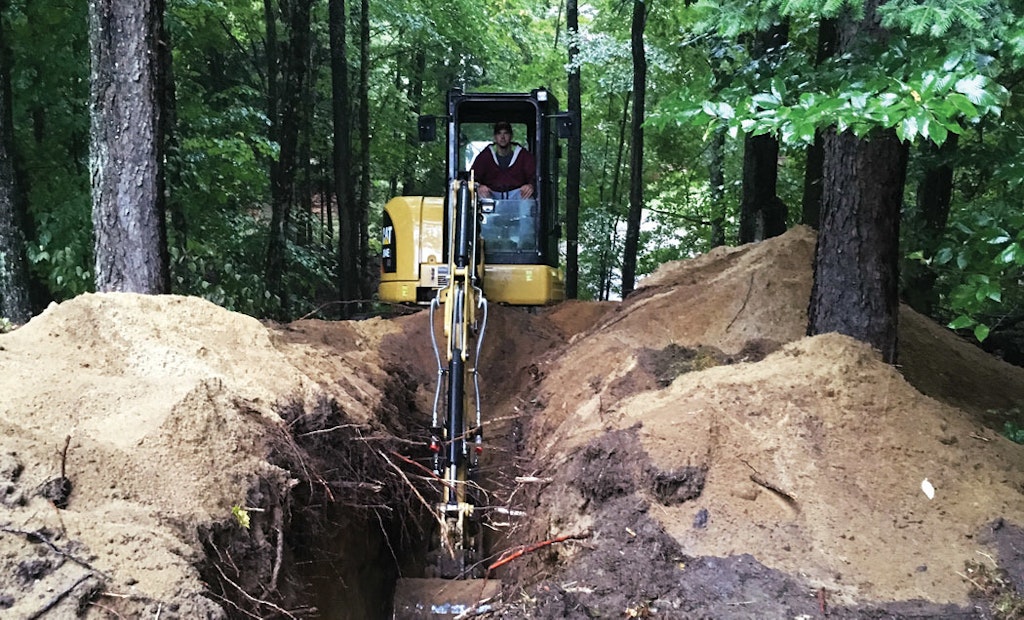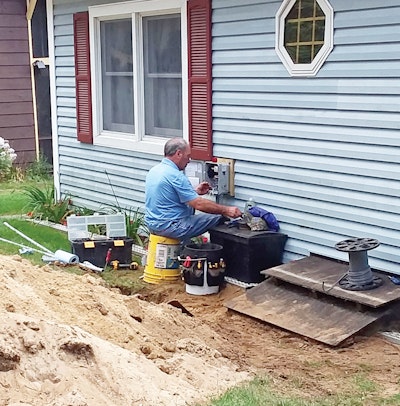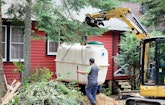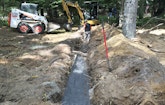
The operator of the Caterpillar 304E2 CR mini excavator tunnels backward through a hill to maintain gravity flow for the 2-inch drinking water supply line. (Photos courtesy of Onsite Engineering)
A homeowner wishing to sell an adjoining property in Saranac Lake, New York, called the state Health Department, which regulates the Back Bay Homeowners Association’s private drinking wells.
His call yanked the finger out of the regulatory dike. Built in the 1920s and ’30s, the 25 seasonal homes were served by two potable wells. State code requires a decentralized water treatment plant, and there was none. Once the health official saw the violation, she was required to evaluate the legacy onsite systems.
Five of the community’s seven concrete block dry wells were larger than 1,000 gpd, and nine pairs of homes shared 500-gallon metal septic tanks. State code requires a decentralized wastewater treatment plant, and there was none. The official reported her findings to the state Department of Environmental Conservation, and the association’s struggle for compliance began.
Over the years, the association hired two engineering firms, but both were in lockstep with regulators over building the water and wastewater treatment plants, which required part-time operators. The multimillion-dollar project was beyond the organization’s financial scope.
A homeowner, who was a university dean of engineering, recommended Eric Murdock of Onsite Engineering in Syracuse. Compared to the expense of building the plants, his innovative gravity-flow design using Fusion ZF-450 purification units (Clarus Environmental, a division of Zoeller) and 3G ultraviolet disinfection chambers (SALCOR) saved the association more money than the cost of the installation.
Unraveling the puzzle
State code specifies that if five or more homes share a potable well, there must be a water treatment plant. Furthermore, if any dispersal area is larger than 1,000 gpd, the Department of Environmental Conservation has jurisdiction. The agency requires those systems to have a State Pollutant Discharge Elimination System permit and a wastewater treatment plant.
Throughout the ordeal, the association volunteered cooperation. In 2017 and as part of the Department of Environmental Conservation’s reasonable potential analysis for nutrients, the association drilled a groundwater monitoring well. The sample revealed nitrates exceeding the allowable level. That August, the agency issued a consent order. “Unfortunately, the monitoring well was only feet from a dry well because they didn’t know it was there,” Murdock says.
In January 2018, he met with association members and soon had a design concept. Murdock discussed his plan to reduce the systems to below regulatory authority with officials from the Department of Environmental Conservation and the Health Department. “They were ecstatic to delete this huge project from their workload,” Murdock says. “The simplest, most cost-effective solution is almost always to split major projects into smaller ones.”
Murdock’s third call was to the local code officer, informing him that the state agencies were sending letters of approval for the design and it was safe to issue the permit.
Planning for success
By adding four potable wells, Murdock’s design ensured no well served more than four homes. This eliminated the Health Department’s role. By installing individual aerobic treatment units and pairing houses to either stone-and-pipe drainfields or dry wells, Murdock eliminated the Department of Environmental Conservation’s requirements.
Using a design flow of 110 gallons per bedroom, Murdock hooked a trio of three-bedroom homes with a combined flow of 990 gallons to a designated drainfield or dry well. This meant adding seven stone-and-pipe drainfields and a trench to two existing fields. “The dispersal areas were in good condition due to the excellent soil and limited usage,” he says.
When the Department of Environmental Conservation accepted Murdock’s proposal, it specified the ATUs must provide nitrogen reduction and be suited for seasonal intermittent use. “The Fusion has plastic media for attached growth microorganisms,” Murdock says. “When the system is off, the culture goes dormant, but it rejuvenates quickly because of the volume. The unit has no mechanical parts to wear out, and flipping a switch turns the power on or off.”
Gary Royce Jr., owner of A+ Excavating in Fulton, and Murdock spent three months planning the installation. To ensure the homes were vacant, they began work the day after Labor Day. However, autumn brings rain in the Lake Placid Region and snow falls by mid-October. To beat the weather and expedite the installation, Royce assigned workers to a specific task, like on an assembly line.
Installation
Tri-Lakes Septic Service pumped the septic tanks before they were decommissioned. “Not much was in them because they were full of holes,” Murdock says.
The wooded area had massive mature trees, often growing close to cottages. The association hired a tree surgeon to remove those trees blocking tank installations. In several instances, a building sewer went through the middle of a nearby root ball and had to be diverted.
“Root balls are as wide as the tree’s canopy,” Murdock says. “It took time to hand-dig around a ball to avoid damaging the roots and weakening the trees in the sandy soil. Luckily, we maintained the correct pitch when installing additional piping.” Building sewers and conveyance lines were 4-inch Schedule 40 PVC pipe. Only 45-degree fittings with clean-outs were used.
The dry weather held for two weeks, enabling the crew to install five tanks and ancillary items per day. They laid 2-inch-thick R-8 rigid foam insulation over the tops and 12 inches down the sides of the tanks to protect them against the 30-below-zero average daily temperatures in January and February. Where possible, they covered the units with 12 inches of sand.
“We made great progress because the sand was easy to dig and there was no groundwater,” Murdock says. “The sand also provided a solid bedding, saving the time and cost of transporting gravel.”
Disinfection systems were housed in six-outlet distribution boxes (TUF-TITE) and air compressors were in nine-outlet boxes, which protected the equipment from the harsh environment. Workers drilled holes in the corners of the compressor boxes for louvers to facilitate airflow, then mounted all the boxes on 24- by 18- by 6-inch-thick stone pads to promote drainage away from them.
Treatment units installed adjacent to traffic areas were barricaded to deflect plows removing an annual average snowfall of 8.5 feet. Royce’s crew drove a 6-by-6-inch post in three corners, then nailed on severe-weather-treated deck boards.
Piping
Drainfields were installed in sand with a percolation rate of 2 to 5 minutes per inch. After excavating 24-inch-wide trenches spaced 4 feet on center, the crew laid 4-inch perforated pipe atop 6 inches of crushed stone, added 2 more inches of stone, covered it with geotextile fabric and backfilled with 12 inches of sand.
Multiple conveyance lines often occupied the same trench. Workers installed piping adjacent to and in roadways 12 inches below grade or lower to support traffic loading.
Trenching for the 2-inch drinking water supply lines often ran through wooded, hilly areas. To maintain gravity flow, the operator of the Caterpillar 304E2 CR mini excavator tunneled through the hills, often with the arm extended its full 11.25 feet.
Extensive preinstallation planning and Royce’s assembly-line approach enabled work to be finished by the end of October and ahead of schedule. “The homeowner association was over the moon,” Murdock says.
Maintenance
Technicians from Onsite Engineering in Syracuse check the blower and UV bulb and test the alarm panel. Annually, they pull samples from each compartment to record transparency, pH, alkalinity and nitrate, and they measure the thickness of floatables and depth of sludge.










